

| This site is dedicated to exquisite wooden kayaks. Here beauty meets performance, and traditional boatbuilding meets Hi-Tech. Toquenatch Creek is located at the gateway to Desolation Sound Marine Park in coastal British Columbia, Canada. Here Jürgen Köppen, has established Toquenatch Creek Cedar Kayaks. |
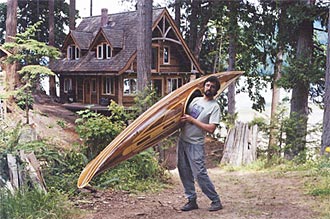 17' Guillemot |
| Our award winning kayaks* are hand crafted using old growth cedar, redwood or mahogany,
and are inlayed with exotic hardwoods.
Since the studio and home are in a remote location, we generate
our power with a micro hydro plant powered by a creek. Hand tools are used for all but the wood strip milling and sanding. Each detail has to pass a strict quality control.
The boats are built one at a time, spending over 350 hours to create a unique piece of quality wood working. You can choose to have your kayak's planking matched or multicolored, displaying the many hues of the wood species. *Seattle Wooden Boat Festival at Lake Union, |
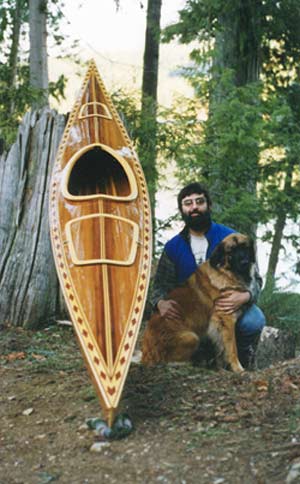 17' Bear Mountain Endeavour |
 |
An earlier kayak, finished Nov.2002. Vaclav Stejskal of "One Ocean Kayak" designed the Cape Ann Expedition. The deck graphics and color choices for "the Flame" were a cooperative effort between Jürgen, and the client Dana in Florida. The deep red planking is bubinga, a beautifully figured tropical hardwood. To reduce weight, those planks are 1/8" cedar with 1/8" bubinga laminated on top. |
| Below is a wooden kayak finished in red and yellow cedar, with purple heart accents and a walnut cockpit. This boat is the first of three 'Cape Ann Expedition' commissions completed in 2001. These are high performance kayak designs, have shown to track very well, yet turn with ease, using the hard chines below and aft of the cockpit. The rudder in the picture had been installed on the clients request, to be able to add a sail rig at a later date. |
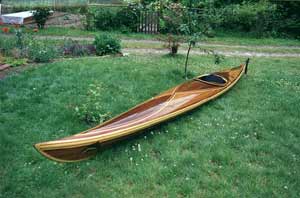 |
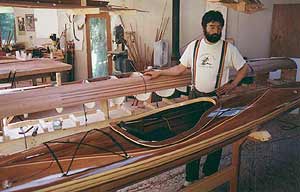 |
| Adam, of Powell River Seakayak, is performing the 'eskimo roll' and giving his expert opinion on the Expedition's technical capacities. |
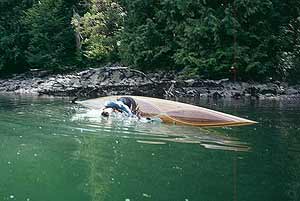 |
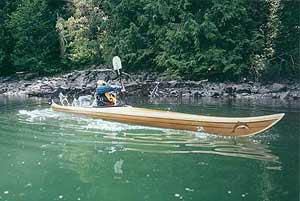 |
| Novices as well as experts can enjoy the fine blend of the characteristics in this kayak. |
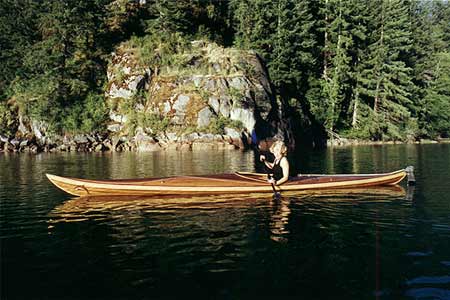
The 2nd kayak of the 2001 Cape Ann series is "Raven". The image on the deck shows Jürgen's marquetry interpretation of a Glen Rabena painting, with permission of the artist.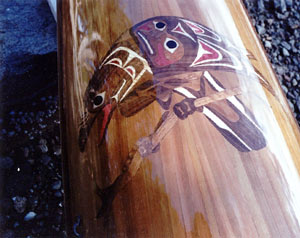 |
 |
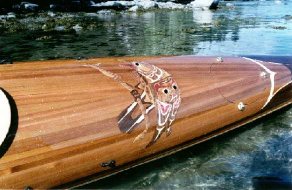
| The last cedar strip kayak completed in 2001 was "Dragonfly", which features a flowing asymmetric deck pattern, as well as mother of pearl and abalone shell inlay. The deck of this boat shows the strong color contrasts in the cedar. The dark brown variety of cedar is difficult to find in long clear length, but can be used in smaller fields. While the color is as rich as walnut, it is light weight enough to be used in a wooden kayak. | 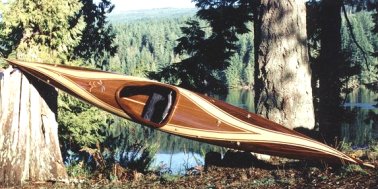
|
| The 2002 Cape Ann Expedition Sport is an even lighter weight, shorter 16'8" version of the kayaks above. More photos of "Moonraven" and a bit of the background and construction details. |

| In the spring 2003, the "Otter" was completed, a Cape Ann Expedition Sport as well. I just added a small page linking to some close-ups |  |
 |
Three of our kayaks shown in the Maritime Art display at The Center for Wooden Boats in Seattle. |
| To find out about the standard components of a typical Toquenatch Creek Kayak, please return to the top and select the "Features" button. If you are curious about pricing, the "Services" button will bring you to the appropriate page. If you are visiting this site in response to the article in "Coastal Living Magazine", and want to see more pictures of our house, you can click here. . If you want a peak into the story behind the kayaks, as it appeared in a shortened version in "Wave Length Magazine", click below. |

| A Cape Ann HV is now under construction in the studio, commissioned by a client in the US. The deck, made of highly figured mahogany, birds eye maple and chocolate cedar around the cockpit, is receiving a collage with four elements: A butterfly, a shell, 3 teardrops, and wheat. All are significant to my client, and have been arranged to flow with the lines of the deck layout. |

| The inlay at this point was not completed yet, the other wheat stalk on the right still needs to receive its grain in yellow cedar, and some grasses will be added at the base. The butterfly is a mix of ebony, bubinga, paua shell, yellow cedar, and mother of pearl. The deck at this point has been sanded to medium fine grit. Once the collage is completed, the whole deck will be glassed and epoxied. |
